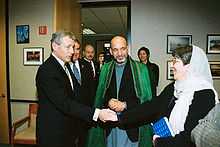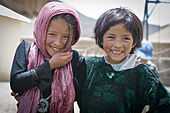Sima Samar
| Sima Samar | |
|---|---|
 | |
| Sima Samar in 2011 | |
| Minister of Women's Affairs of Afghanistan | |
| In office December 2001 – 2003 | |
| President | Hamid Karzai |
| Preceded by | None |
| Succeeded by | Habiba Sarabi |
| Personal details | |
| Born | 3 February 1957 |
| Political party | Truth and Justice |
| Religion | Islam |
|
Part of a series on
|
Sima Samar (Persian: سیما سمر) (born 3 February 1957) is a well known woman’s and human rights advocate, activist and a social worker within national and international forums, who served as Minister of Women's Affairs of Afghanistan from December 2001 to 2003. She is currently the Chairperson of the Afghan Independent Human Rights Commission (AIHRC) and, since 2005, United Nations Special Rapporteur on the situation of human rights in Sudan. In 2011, she was part of the newly founded Truth and Justice party.
Early life and education
Samar was born in Jaghori, in Ghazni Province of Afghanistan, on 3 February 1957. She belongs to the ethnic Hazara group. She obtained her degree in medicine in February 1982 from Kabul University. She practiced medicine at a government hospital in Kabul, but after a few months was forced to flee for her safety to her native Jaghori, where she provided medical treatment to patients throughout the remote areas of central Afghanistan. She was an active member Hazara group under the leadership of Baba Mazari, a Hazara leader who was fighting against Racial injustice, and promoting unity and brotherhood of all ehtnicities, therefore equal rights in Afghanistan; she is head of human rights commission in Afghanistan. Baba Mazari was a remarkable supporter of Women Rights.
Career
In 1984, the communist regime arrested her husband, and Samar and her young son fled to neighboring Pakistan. She then worked as a doctor at the refugee branch of the Mission Hospital. Distressed by the total lack of health care facilities for Afghan refugee women, she established in 1989 the Shuhada Organization and Shuhada Clinic in Quetta, Pakistan. The Shuhada Organization was dedicated to the provision of health care to Afghan women and girls, training of medical staff and to education. In the following years further branches of the clinic/hospital were opened throughout Afghanistan.

After living as refugee for over a decade, Samar returned to Afghanistan in 2002 to assume a cabinet post in the Afghan Transitional Administration led by Hamid Karzai. In the interim government, she served as Deputy President and then as Minister for Women's Affairs. She was forced into resignation from her post after she was threatened with death and harassed for questioning conservative Islamic laws, especially sharia law, during an interview in Canada with a Persian-language newspaper. During the 2003 Loya Jirga, several religious conservatives took out an advertisement in a local newspaper calling Samar the Salman Rushdie of Afghanistan.
She is currently the head of Afghanistan Independent Human Rights Commission (AIHRC).She established Gawharshad Institute of Higher Education in 2010.[1] She is one of the 4 main subjects in Sally Armstrong's 2004 documentary Daughters of Afghanistan. In the documentary, Sima Samar's work as the Minister of Women's Affairs and her subsequent fall from power is shown. she established in 2010 an institute of higher education which called Gawharshad. this institute has attracted more than 1200 students in in a very short amount of its activities.
Dr. Samar publicly refuses to accept that women must be kept in purdah (secluded from the public) and speaks out against the practice of wearing the burqa (head-to-foot wrap), which was enforced first by the fundamentalist mujahideen and then by the Taliban. She also has drawn attention to the fact that many women in Afghanistan suffer from osteomalacia, a softening of the bones, due to an inadequate diet. Wearing the burqa reduces exposure to sunlight and aggravates the situation for women suffering from osteomalacia.[citation needed]
Politics
She became a member of the Truth and Justice party which was formed in 2011.
Awards

Dr. Sima Samar has received numerous international awards[2] for her work on human rights and democracy, including:
- 1994 Ramon Magsaysay Award for Community Leadership;
- 1995 Global Leader for Tomorrow from the World Economic Forum in Switzerland;
- The 1998 100 Heroines Award in the United States;
- The Paul Grunninger Human Rights Award, Paul Grunninger Foundation, Switzerland March 2001;
- The Voices of Courage Award, Women’s Commission for Refugee Women and Children, New York, June 2001;
- The John Humphrey Freedom Award, Rights & Democracy, Canada 2001;[3]
- Ms. magazine, Women of the Year on behalf of Afghan Women, USA December 2001;
- Women of the Month, Toronto, Canada, December 2001;
- Best Social Worker Award, Mailo Trust Foundation, Quetta, Pakistan March 2001;
- International Human Rights Award, International Human Rights Law Group, Washington, DC April 2002;
- Freedom Award, Women’s Association for Freedom and Democracy, Barcelona July 2002;
- Lawyers Committee for Human Rights, New York October 2002;
- The Perdita Huston Human Rights Award 2003;
- Profile in Courage Award 2004; and
- One of A Different View's 15 Champions of World Democracy in January 2008 [4]
- Peace Prize of the City of Ieper (Ypres) Belgium, 2008
- Asia Democracy and Human Rights Award, December 2008[5]
- Honorary Officer of the Order of Canada, 2009[6]
- Right Livelihood Award, 2012[7][8]
- Honorary Doctorate from Salem State University in May 2013
Notes
- ↑ http://en.wikipedia.org/wiki/Gawharshad_institute_of_higher_education#Board_of_trustees
- ↑ Honors listed in citation for the 2003 Perdita Huston Human Rights Award accessed at Oct 20, 2006
- ↑ "John Humphrey Freedom Award 2009". Rights & Democracy. 2010. Retrieved 11 May 2011.
- ↑ A Different View, Issue 19, January 2008.
- ↑ "The Asia Democracy and Human Rights Award". Tfd.org.tw. Retrieved 2012-05-08.
- ↑ "Governor General announces 60 new appointments to the Order of Canada". July 1, 2009.
- ↑ http://www.washingtonpost.com/world/europe/right-livelihood-awards-or-alternative-nobels-to-activists-in-us-uk-afghanistan-turkey/2012/09/27/08e6b15c-087b-11e2-9eea-333857f6a7bd_story.html
- ↑ "Alternative Nobel Prize to Hazara Human Rights Activist Sima Samar"
External links
| Wikimedia Commons has media related to Sima Samar. |
- Ms. magazine "A Voice for the Voiceless" Winter 2007 conversation with Sima Samar and Ms. executive editor Katherine Spillar.
- The New England Journal of Medicine "Despite the Odds -- Providing Health Care to Afghan Women" Vol. 351, No. 11 (2004).
Other Afghan Human Rights Activists
| Government offices | ||
|---|---|---|
| Preceded by None |
Minister of Women's Affairs of Afghanistan December 2001 – 2003 |
Succeeded by Habiba Sarabi |
| |||||||||||||||||
|
